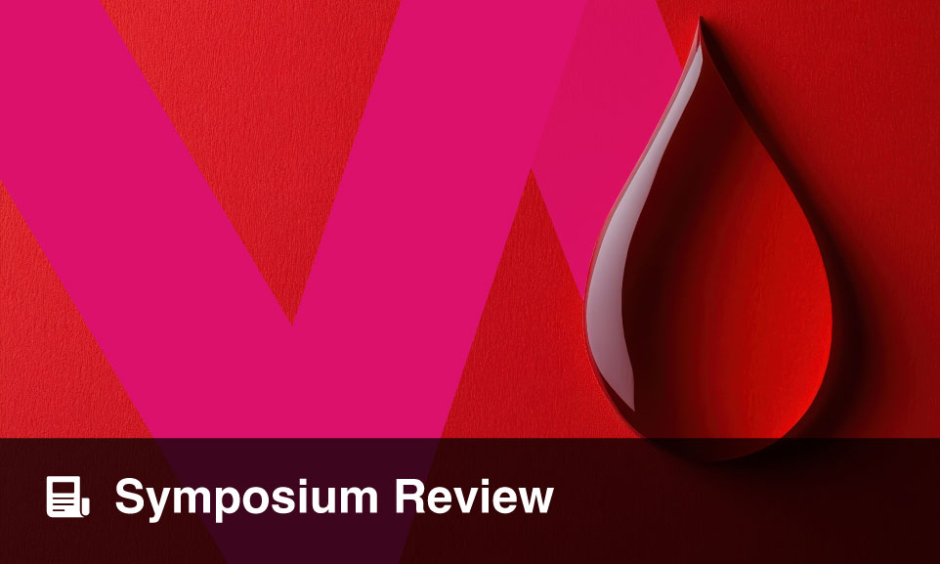THE EUROPEAN Hematology Association (EHA) successfully brought together clinicians and researchers from all over the world to share the latest advances in the field of haematology in its 27th Annual Congress, and its first ever hybrid congress. The EHA 2022 Hybrid Congress was held in Vienna, Austria, with the new format allowing healthcare practitioners to engage both online and in person for the first time since the start of the pandemic. With the EHA celebrating its 30th anniversary, the congress provided a fantastic opportunity for this large network of professionals to connect once again, and advance individual and collective understanding of haematology care.
In her opening ceremony address, EHA President, Elizabeth Macintyre, praised the EHA community: “The pandemic showed that our community is capable of facing challenges, sticking together and delivering excellence in every sense of the word.” Discussing the response to another crisis that has arisen since the last EHA Congress, the President went on to address the ongoing conflict in Ukraine, and lauded the Ukrainian people, stating: “Ukrainian people gave resilience a new meaning. In particular, we applaud the efforts of the Ukrainian haematology teams who kept going under extreme circumstances, delivering healthcare to patients who needed it most.” A clear theme that arose throughout the Congress was community, with the introduction of a Patient Advocacy Committee representing patients’ interests outside of EHA.
The 9-day congress was divided into three hybrid and four fully virtual days, and offered thematic days, as well as more than 180 scientific sessions. These covered a wide range of topics in haematology, including educational sessions. Kirsten Grønbæk, Chair of the Scientific Programme Committee, highlighted: “One of the special topics this year is around Big Data, artificial intelligence, and ethics. The new developments in this field are moving along rapidly.” Important for all clinicians were the guidelines sessions on a broad range of topics, such as stem cell transplantation, alongside sessions on how to handle haematological patients in the post-COVID era.
With an outstanding number of abstracts submitted, a variety of research was shared at this year’s hybrid congress. Several of these abstracts have been summarised and included in this issue of EMJ Hematology. These included a single institution retrospective study into relapses of patients with acute myeloid leukaemia who have received allogeneic stem cell transplant, as well as a study examining the impact of the severe acute respiratory syndrome coronavirus 2 vaccine on severe aplastic anaemia disease status, and establishing the humoral and cellular response to the vaccine.
While the Committee commended the contribution of a multitude of esteemed professionals to the field of haematology, three major awards were presented at this year’s congress. The winner of the José Carreras Lecture and Award 2022 was Marina Cavazzana, in recognition of her role as an established and active investigator who has made an important contribution to haematology. This year, the David Grimwade Award 2022 was granted to Elaine Dzierzak for her outstanding contributions in the field of basic and translational malignant haematology. Finally, the prestigious Jean Bernard Lifetime Achievement Award 2022 was presented to Gert Ossenkoppele for his outstanding contribution to the advancement of haematology.
As last year’s wish to walk the Viennese Ringstrasse alongside our haematology colleagues this year became reality, both the speakers and the team at EMJ were excited to be back as a community to share and explore key insights in haematology care. The EMJ team are looking forward to attending the EHA Hybrid Congress in 2023 in Frankfurt, Germany; however, for now, please enjoy our highlights and reviews of the 2022 congress.
Quizartinib Demonstrated Promising Potential for Overall Survival in Acute Myeloid Leukaemia
APPROXIMATELY 25% of newly diagnosed cases of acute myeloid leukaemia (AML) carry the FLT3-internal tandem duplication (ITD) gene mutation. The mutation promotes disease progression, creating high leukaemic burden, and is associated with the unfavourable prognosis of shorter overall survival and increased relapse risk. New research data has demonstrated quizartinib addition could significantly improve overall survival.
As a highly potent and specific type II FLT3 inhibitor, quizartinib was developed specifically for FLT3-ITD positive AML. The study, carried out at Duke University, Durham, North Carolina, USA, investigated patient outcomes when quizartinib is added to standard induction and post-remission consolidation therapy followed by single-agent continuation of quizartinib. The experiment was trialled for up to 3 years, and improved overall survival in patients diagnosed with FLT3-ITD positive AML.
Patients receiving the standard induction therapy with the addition of quizartinib had significantly improved overall survival compared with those treated with standard induction alone. Median overall survival was 31.9 months for patients receiving quizartinib compared with 15.1 months for those on the standard treatment. Furthermore, quizartinib’s safety profile was comparable to previous studies with the presence of neutropenia, prolonged QT on the electrocardiogram, and an increased rate of discontinuation due to adverse events than patients on the standard treatment.
From the results, the study authors concluded that statistically significant and clinically meaningful improvement in overall survival could be achieved by the addition of quizartinib to standard induction and consolidation therapy.
Promising Survival Rates with Decitabine Treatment in Acute Myeloid Leukaemia
IN OLDER patients diagnosed with acute myeloid leukaemia (AML), decitabine treatment has been found to result in similar survival rates, and also presents fewer adverse events, when compared to traditional induction chemotherapy.
AML typically occurs in patients over the age of 65. This patient group exhibits a lower tolerance to conventional induction chemotherapy in comparison to younger patients. Older patients receiving induction chemotherapy have poorer long-term survival without haematopoietic stem cell transplantation (HSCT).
Throughout the last decade, DNA-hypomethylating agents like decitabine have been given as a safer alternative treatment for patients for whom induction chemotherapy is unsuitable. Previous research has demonstrated that prolonged (10-day) decitabine treatment is promising in older patients with AML, showing encouraging efficacy. Decitabine may therefore be a more suitable treatment than HSCT in fit patients.
An open-label, randomised, Phase III study, led by the European Organisation for the Research and Treatment of Cancer (EORTC) Leukemia Group, included 606 participants over the age of 60. Researchers compared both efficacy and safety of 10-day decitabine alongside conventional 3+7 induction chemotherapy in patients with recently diagnosed AML.
Although induction chemotherapy achieved overall higher complete remission than decitabine (61% versus 48%), the survival level was comparable, with a median overall survival of 15 months (decitabine) and 18 months (induction chemotherapy). After 4 years, 26% of patients in the decitabine cohort, and 30% from the induction chemotherapy arm were alive.
Researchers discovered that a notable difference between both treatments was the number of Grade 3–5 adverse advents prior to HSCT. Decitabine treatment demonstrated lower incidences of oral mucositis, febrile neutropenia, platelet reduction, and diarrhoea. The study concluded that in older patients with AML, decitabine treatment signified a superior safety profile in comparison with induction chemotherapy, whilst continuing to uphold similar overall survival and rates to treatment with HSCT.
Novel CAR-T Cell Therapy for Patients with Relapsed/Refractory Multiple Myeloma
A NOVEL chimeric antigen receptor (CAR)-T cell therapy, which targets B cell maturation antigen (BCMA), has been found a highly effective treatment for patients with relapsed or refractory multiple myeloma.
CAR-T cell therapy is a type of immunotherapy, in which genetically engineered T cells target a specific protein. Since 2017, when it was first approved by the U.S. Food & Drugs Administration (FDA), CAR-T cell therapy has been used consistently as a treatment for blood cancers, including multiple myeloma. Researchers are continuing to discover new cancer cell targets, which allows CAR-T cells to be further customised to suit specific patients.
In a multicentre study (CARTBCMA-HCB-01), researchers evaluated the safety and effectiveness of a novel autologous CAR-T cell product (ARI0002h), which targets BCMA, in patients diagnosed with relapsed and refractory multiple myeloma. Patients were eligible for inclusion in the study provided they had a refractory disease, and had received >2 regimens previously, including an immunomodulatory drug, an anti-cluster of differentiation 38 antibody, and a proteosome inhibitor.
In total, 35 patients with a median age of 61 years, participated in the trial. Of these patients, 30 were eligible to receive a targeted dose of 3×106 CAR+ cells /kg. The production time of CAR-T cells took an average of 11 days, and the success rate was measured at 100%. Ninety percent of this cohort showed complete remission, and very good partial response. The time to first response took an average of 1 month, and 92% of patients in the minimal residual disease (MRD) cohort were MRD-negative in their bone marrow at Day 100 following infusion. Eighty percent of patients survived for 16 months following treatment, and 53% had no further disease progression. In a cohort of 28 eligible patients, 86% received a second dose of CAR+ cells, and 29% showed an improved response following this reinfusion.
The study’s outcome measures included the overall response rate, which was defined as at least partial response according to the International Myeloma Working Group (IMWG) criteria; bone marrow MRD in the 3 months following the initial infusion; and the rate of neurological toxicity and/or cytokine release syndrome in the first 30 days. Researchers concluded that ARI0002h is an effective treatment for patients with relapsed/refractory multiple myeloma, and the response may be boosted with a second dose.
Achieving Progression-Free Survival in Patients with Chronic Lymphocytic Leukaemia
CHEMOIMMUNOTHERAPY (CIT) is considered the gold standard for treating patients with chronic lymphocytic leukaemia (CLL); however, it is not suitable for all patients due to adverse side effects. Results from the GAIA/CLL 13 study, presented by Barbara Eichhorst, University of Cologne, Germany, at the EHA2022 Congress indicate that there are superior options available.
According to Eichhorst, venetoclax plus obinutuzumab (GV) and GV and ibrutinib (GIV) are better alternatives to CIT as treatment for patients with CLL who are treatment-naïve. By targeting particular molecules that are associated with the development and progression of CLL, new treatments could reduce the collateral damage to healthy cells.
The GAIA/CLL 13 study recruited 926 fit patients with CLL who were treatment-naïve to compare CIT with GV and GIV. In the CIT group, individuals under the age of 65 were treated with a combination of fludarabine, cyclophosphamide, and rituximab. Patients who were older than 65 were treated with bendamustine and rituximab. In the venetoclax group, patients with treated with either a combination of venetoclax and rituximab (RV), GV, or GIV.
An interim analysis of progression-free survival after 61 months proved that treatment with GV and GIV was superior (hazard ratio: 0.32 and 0.42, respectively). However, there was no significant difference in progression-free survival from patients treated with CIT and RV. Overall survival rates were comparable across all groups, with no difference in haematological side effects being observed.
Despite these promising results, Grade 3 and 4 infections were more common in patients treated with GIV (21.2%). Grade 3 and 4 infections occurred less frequently in patients treated with CIT (18.5%), GV (13.2%), and RV (10.5%); however, the rate of secondary neoplasia was increased in patients treated with CIT.
While the GAIA/CLL 13 study indicates that GV is a superior option to treat patients with CLL than CIT, whether GIV is superior to GV will be tested further.
Ribosome Component Overexpression Drives Haematopoietic Stem Cell Exhaustion
RESEARCHERS at the Centro Nacional de Investigaciones Oncólogicas, Madrid, Spain, aimed to analyse and describe how dysregulation of ribosomal components may impact haematopoietic stem cell biology and lead to diseases that cause bone marrow failure. The translation of messenger RNA (mRNA) is a process requiring intricate crosstalk between the nucleoli and the ribosomes. Impairment due to abnormal function or structure of ribosomal components may lead to pathologies, including cancer. The researchers investigated on one such component, hnRNP protein K, a binding protein that processes pre-mRNA in the nucleoli into mature mRNA ready for translation by ribosomes.
The investigators overexpressed the gene Hnrnpk in mouse embryonic fibroblasts before exposing them to actinomycin D to trigger nucleolus stress. Confocal microscopy, flow cytometry, and quantitative reserve transcription-PCR were used to assess levels of nuclear stress and investigate underlying molecular mechanisms. Inducible tamoxifen mouse models were used to assess the impact of Hnrnph on survival and phenotype.
The results demonstrated that the overexpression of Hnrnpk resulted in elevated gene and protein expression of nucleolin, mammalian target of rapamycin, and c-Myc. Furthermore, the cells expressed an increase in global protein synthesis which was inversely correlated to proteasome function. The overexpressed cells showed increased numbers of nucleoli, enlarged total area of nucleoli, and were more likely to display a senescent cell phenotype, all hallmarks of nucleolus stress. The inducible tamoxifen mice models exhibited a reduced lifespan with analysis showing a strong reduction in CD34 cells and B cells, with leukopenia, anaemia, and thrombocytopenia. The shortened lifespan of the mice was primarily due to dysplastic bone marrow and bone marrow failure.
Researcher concluded that this data indicated overexpression of the hnRNP protein K component induced an increase in nucleoli activity through ribosome biogenesis and increased translation followed by cell senescence. This dysregulated phenotype is subsequently linked to bone marrow failure and haematopoietic stem cell exhaustion.







